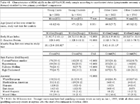Clinical Measurements Summary
Through a phone interview, an extensive self administered questionnaire, and the use of the KPNC electronic databases, we documented the presence or absence and age of onset of clinically significant CAD, ischemic stroke, and PAD, as well as all traditional risk factors for atherosclerosis. Subjects also provided information on race/ethnicity and were classified into one of nine race/ethnic groups: white/Europeans, black/African Americans, Hispanics, South Asians, East Asians, Pacific Islanders, Native Americans, admixed Hispanics, and admixed non-Hispanics. At the clinic visit, we measured the height and weight of all participants and collected blood for DNA extraction.
Traditional risk factors (smoking, hypertension, high cholesterol, and diabetes) were defined based on self report and were considered to be present only if subjects reported an age of onset of a risk factor that was younger than the age of onset of clinically significant CAD.
Classification of Race/Ethnicity
Race/ethnicity data was available from several data sources including: screening survey and baseline health survey self-reported race/ethnicity, self-reported birthplace, grandparents’ race/ethnicity, grandparents’ country of origin, and the self-reported race/ethnicity information from KPNC databases. Following completion of recruitment, a uniform algorithm was used to assign race/ethnicity for all cohorts not involving CARDIA patients. If self-reported and all grandparents’ race/ethnicity were concordant, then subjects were coded to that race/ethnicity category (>80% of subjects). Discordant cases were reviewed and the following hierarchy was used to assign race/ethnicity: grandparents’ race/ethnicity, grandparents’ country of origin, subjects’ self reported ethnicity, screening data self-reported race/ethnicity. Persons of mixed race/ethnicity with any indication of Hispanic heritage were assigned as ‘admixed Hispanic’. Other admixtures were assigned to a ‘admixed Non-Hispanic’ category.
For CARDIA participants, race/ethnicity was assigned by CARDIA investigators and was based on self reported ethnicity and parents’ ethnicity.
Non-Genetic Characteristics of the ADVANCE study sample
The ADVANCE study sample consisted of 3546 subjects. Characteristics of the study sample are summarized in below (see Tables 3S and 4S in the supplementary appendix for characteristics stratified by sex). The younger age of cases in the set of older onset cases and controls was a consequence of stratified sampling. Stratified sampling and/or preferential participation also led to differences in the prevalence of certain race/ethnic groups by case/control status and to the low prevalence of young cases that were male.
| Table 1
|
Table 3s |
Table 4s |
References
- Hiatt RA, Friedman GD. Characteristics of patients referred for treatment of end-stage renal disease in a defined population. Am J Public Health 1982; 72:829-33.
- Krieger N. Overcoming the absence of socioeconomic data in medical records: validation and application of a census-based methodology. Am J Public Health 1992; 82:703-10.
- Hughes GH, Cutter G, Donahue R, et al. Recruitment in the Coronary Artery Disease Risk Development in Young Adults (Cardia) Study. Control Clin Trials 1987; 8:68S-73S.




